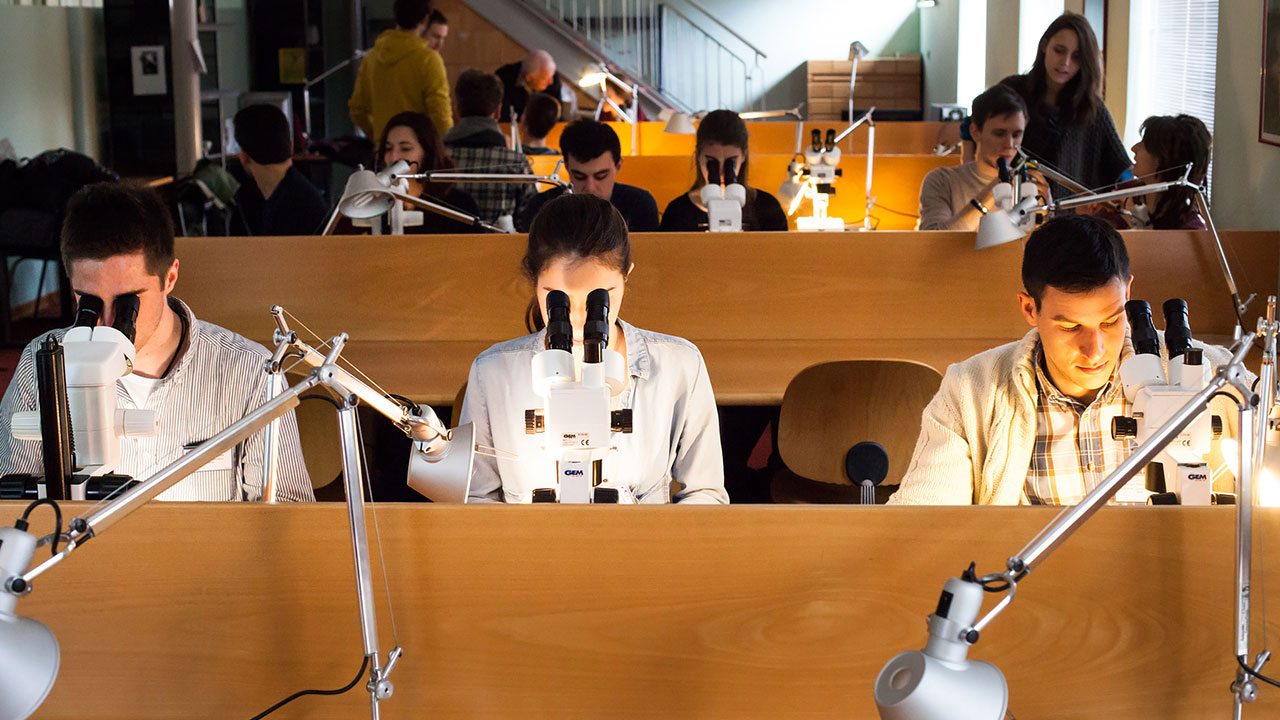International Diamond School
International Diamond School
In late January 2015, nearly 100 scientists gathered in the northern Italian town of Brixen to attend the Second International Diamond School (IDS). The program, titled “The Nature of Diamonds and Their Use in Earth’s Study,” was designed so that attendees from varied educational and professional levels could learn from leaders in the field of natural diamond research.The school successfully blended student and professional perspectives, as well as the cross-disciplinary nature of the participants and speakers. Over four days, IDS attendees from a wide range of backgrounds—including experimental researchers, petrologists, mineralogists, crystallographers, isotope geochemists, and diamond industry experts—were treated to a wide scope of lectures and workshops. Presentations provided insight into diamond exploration, advanced research-level analysis, diamond morphology, inclusion chemistry, and geologic occurrences.
George H. Read (Shore Gold Inc., Vancouver) presented a recent history of diamond exploration, culminating with his company’s new Canadian diamond mine: Star-Orion in Saskatchewan, a $2.5 billion project. He provided context on production history, sources, and trading centers. He outlined future diamond mining projects in Botswana, Canada, Lesotho, and India, concluding that the small number of viable projects might signify a shortfall in rough supply. The complexity and financial risks involved with bringing new diamond mines online was made evident.
Bruce Kjarsgaard (Geological Survey of Canada, Ottawa) reviewed kimberlite eruptive models based on 1970s and 1980s research in South Africa. He explained the revision of these models after new kimberlite discoveries in the 2000s in Canada’s Slave craton. He defined kimberlite as a strongly homogenized and “mixed-up” hybrid rock, representing a blend of crystallization out of the magma with country rock, that is often highly variable from place to place. In a second presentation Kjarsgaard examined the major techniques used for exploration for diamondiferous kimberlites, focusing on the Canadian experience and its applicability to glaciated shield areas such as Canada, Russia, the northern United States, and Finland. These techniques have been remarkably successful, partly because of the solid scientific research behind them.
Jeff Harris (University of Glasgow, UK) reviewed the characteristics of lithospheric diamonds based on his experience as a De Beers research director and his access to an unparalleled proportion of run-of-mine diamonds. He showed how different pipes produce distinct diamond size ranges and morphologies. He covered the age relationships between inclusions and host diamond, inclusion chemistry, formation pressures and temperatures, fluid inclusion chemistry, and the abundance of different carbon and nitrogen isotopes in diamond.
Michael Walter (University of Bristol, UK) discussed the super-deep carbon geodynamics of Earth’s mantle along with information provided by analysis of lower-mantle fluids found as inclusions in “superdeep” (sublithospheric) diamonds from Brazil’s Juina field. He explained how new thinking over the past five to six years has provided a model for diamond formation by subduction of carbonate-bearing hydrated oceanic crust in the transition zone of the mantle at depths of 440 to 600 km.
Paolo Nimis (University of Padua, Italy) discussed thermobarometry, a technique that uses mineral phase diagrams to discover the original formation conditions (pressure, temperature, and therefore depth) of rocks in the mantle. He also related the possibility of applying similar techniques to inclusions in diamonds to help determine their formation conditions. His talk explored the accuracy and precision of the different thermobarometers and where future improvements are likely to occur.
Ross Angel (University of Padua) discussed elastic barometry for inclusions in diamonds. This new field uses Raman shift or X-ray diffraction (lattice distortion) to measure decompression effects on the surrounding diamond crystal caused by inclusions formed at high pressure to estimate pressure of diamond formation.
Fabrizio Nestola (University of Padua) explained the advanced X-ray diffraction methods used in their laboratory, which permit very rapid crystal orientation and data collection. This work has shown that some olivine inclusions cannot be syngenetic, as they share no preferred orientation with the host diamond.
Graham Pearson (University of Alberta, Canada) overviewed the petrology and geochemistry of cratonic mantle roots. He explained the effects of melt depletion (removal of clinopyroxene and orthopyroxene) to produce very magnesium-rich melts in the sub-continental mantle, which removes rhenium (Re) to “freeze in” the osmium (Os) isotopic system to allow radiometric dating. This gives very different mean Re/Os model ages for “on-craton” (2.5 billion years) and “off-craton” (2.0 billion) mantle xenoliths (potential diamond host rocks) for the Kaapvaal craton, which underlies southern Africa.
Steven Shirey (Carnegie Institution of Washington) reviewed the topic of age-dating diamonds, beginning with work in the 1980s using rare-earth element ratios in silicate mineral inclusions within the diamonds. He covered rhenium/osmium dating techniques devised in the late 1990s and perfected in the 2000s, finishing with recent Re/Os dating work on zoned diamonds from Yakutia, which showed two-billion-year-old cores surrounded by younger rims of one billion years.
Oded Navon (Hebrew University of Jerusalem) presented on silicic and low-magnesium carbonatitic fluids in fibrous diamonds and their relationship to fluids in gem-quality diamonds. He explained how new work on inclusions along the twin planes of otherwise gem-quality diamonds—macles—revealed fluids of very similar compositions. One can generalize from previous studies of fibrous diamond that most diamonds form under similar growth conditions most of the time.
Thomas Deining (WITec Instruments Corp., Ulm, Germany) introduced WITec’s confocal Raman spectrometer system and described its ability to map three-dimensional fields of features at very high resolution. This instrument is ideally suited to looking into diamond, and his talk set the stage for the Raman workshops the following day.
Maya Kopylova (University of British Columbia) discussed fluid inclusions and volatiles in monocrystalline, octahedral diamonds, with a focus on nitrogen (N2) and carbon dioxide (CO2). She related this new work to previous studies on fibrous diamonds, showing it has wider relevance than previously thought.
Wuyi Wang (GIA, New York) covered diamond treatment and synthesis. He introduced the various causes of color in natural diamonds and explained how combinations of irradiation and high-pressure, high-temperature (HPHT) treatment might alter or remove color. He also reviewed improvements in synthetic diamond size and quality due to advances in HPHT and chemical vapor deposition (CVD) synthesis technology.
Frank Brenker (Goethe University, Frankfurt) outlined the latest findings on ultra-high pressure mineral phases in diamonds. Much of this work is nanostructural in nature and requires removing exceptionally thin wafers of diamond by focused ion beam lithography, a technique borrowed from the electronics industry. Brenker dealt specifically with the idea that some of the inclusion minerals thought to have grown in the lower mantle (e.g., Mg perovskite and ferropericlase) might actually have formed at the shallower depths of the mantle transition zone or even the upper mantle.
Dan Frost (University of Bayreuth, Germany) presented on the experimental petrology of the mantle, using state-of-the-art multi-anvil presses capable of achieving pressures of 250,000 bar at 1,800°C. This work demonstrates the possibility that at certain temperatures and pressures, a system may exist where carbon dioxide (CO2) and methane (CH4) produce carbon (C) plus water (H2O). He presented this as a new model for diamond formation in the deep mantle.
Pierre Cartigny (Institut de Physique du Globe de Paris) showed how carbon and nitrogen isotopes are used to characterize the fluid sources and fractionations that can occur with diamond growth. One of his long-standing conclusions is that even though subduction of C and N can occur and is thought to be a major process for introducing fluids into the mantle, the signatures of subduction are not as clear as one would expect. The possible isotopic changes that can occur between the diamond and its host fluid during diamond growth need much further study.
Andy Davy (Rio Tinto Plc., Bristol, UK) drew upon his experience as a consulting geologist to discuss the role of engineers and natural diamond scientists in evaluating diamond deposits. His talk covered the exploration and evaluation of prospective deposits, improvements in recovery methods to prevent diamond breakage, and assessing the performance of deposits through time. He left the audience with a realistic picture of the complications in establishing diamond grade, price, and hence the viability of any given diamond project. He further showed how exceedingly rare good diamond-producing kimberlites are.
The school was a fantastic opportunity for attendees to learn about diamond exploration, advanced research-level analysis, diamond morphology, inclusion chemistry, and geologic occurrences in a way that will inspire their future studies and career choices. GIA’s contribution directly benefited these up-and-coming research scientists by reducing the attendance fees for the conference, permitting many students to attend who otherwise would have been unable to do so.
IDS was organized by Fabrizio Nestola, Graham Pearson, and Steven Shirey, under the auspices of the Diamonds and Mantle Geodynamics of Carbon (DMGC) consortium, part of the Deep Carbon Observatory (DCO). The school was sponsored by GIA, the DCO, the Italian Society of Mineralogy and Petrology (SIMP), and the University of Padua. The IDS website is at www.indimedea.eu/diamond_school_2015.htm.












